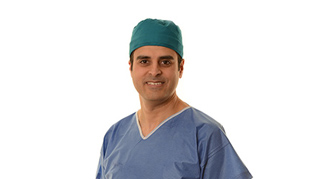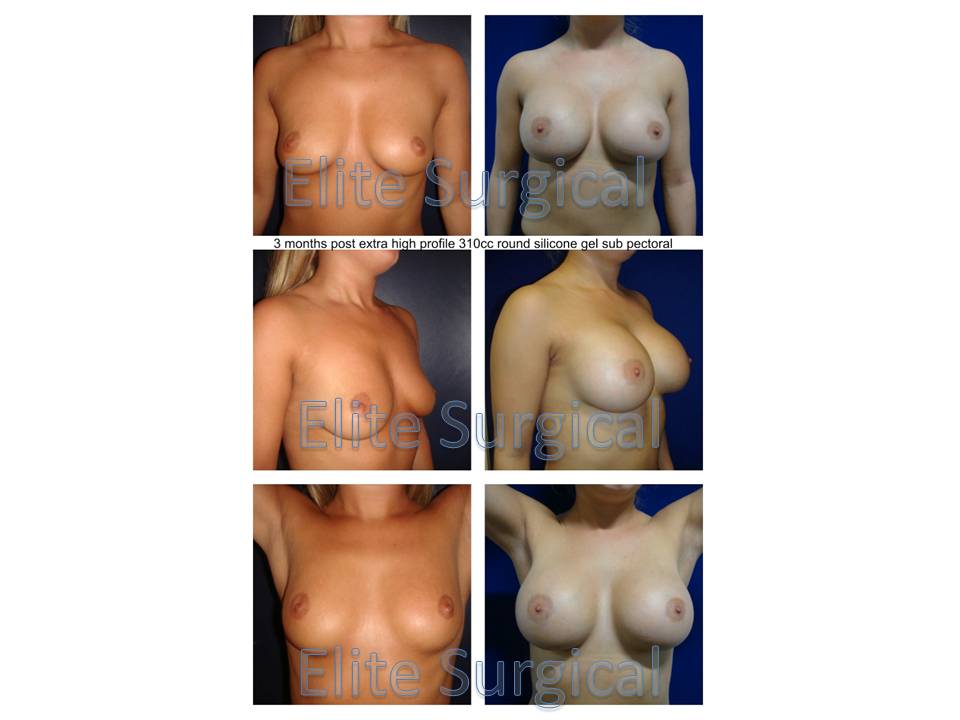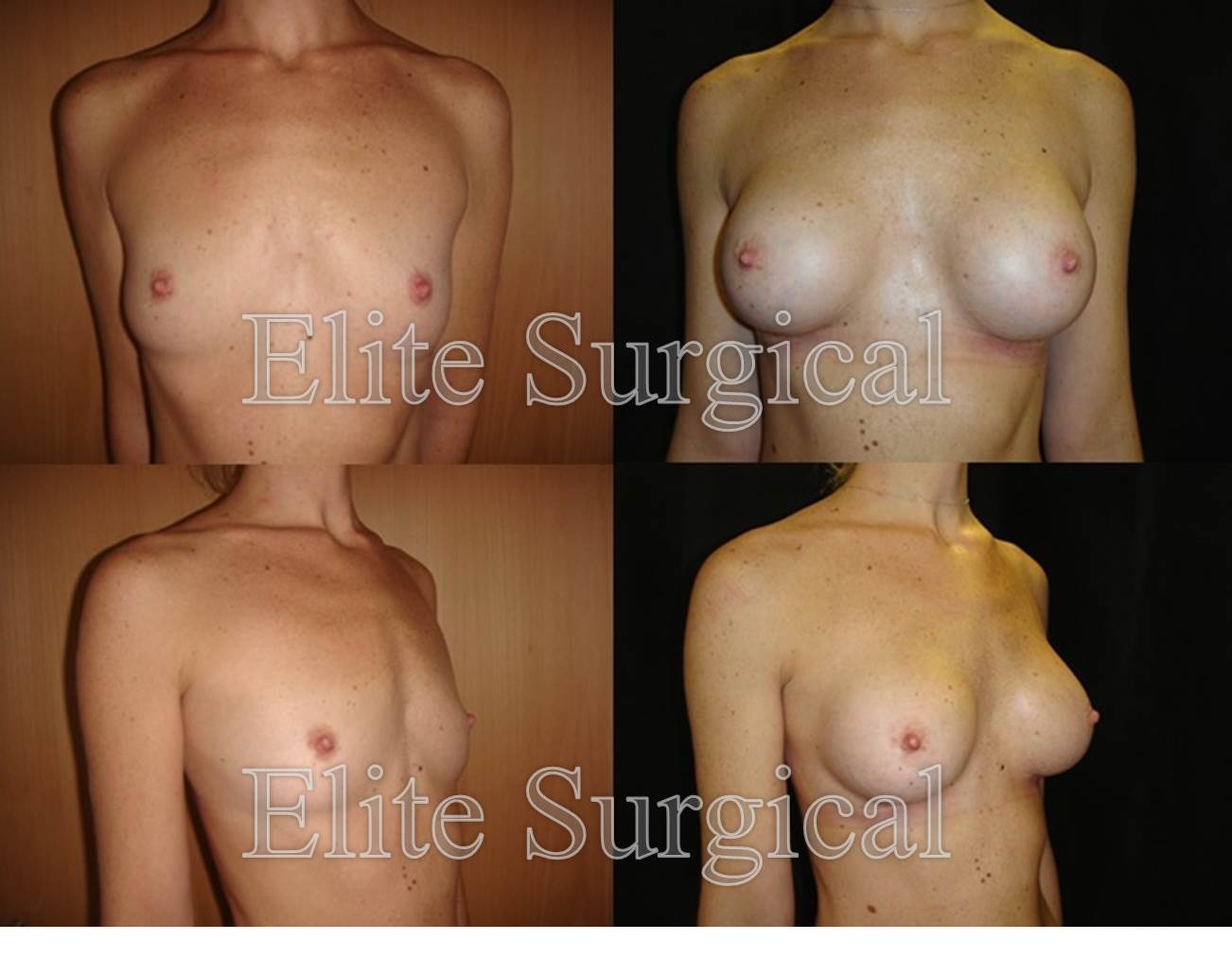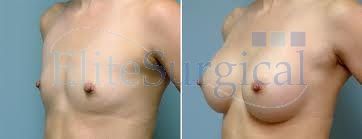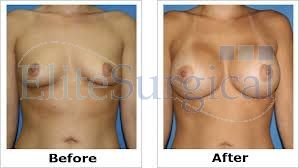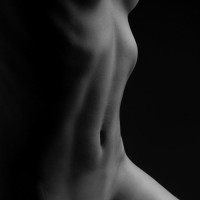Breast Augmentation / Enlargement with Implants
Breast augmentation/enlargement is a surgical procedure that involves inserting breast implants to increase the size of the breasts, change their shape, or to correct asymmetry. Breast Surgery can also restore volume that has been lost due to pregnancy or breast feeding.
The procedure is carried out using a general anaesthetic and takes about one hour. It can be done as a day case but usually you will stay in hospital for one night. There will be swelling and bruising after the surgery and you can expect to feel pain and discomfort for between three and seven days. The wounds will be covered with tape after surgery which should be left in place for three weeks. It is recommended that you wear a supportive bra day and night for the first three months. Scars are inevitable but will gradually fade. Avoid strenuous exercise and lifting heavy objects for six weeks after the surgery.
At Elite Surgical we predominantly use Polytech implants (see our section on implants for more information).
Need: Breast augmentation is one of the most commonly performed cosmetic surgery procedures in aesthetic surgery. The operation is also referred to by patients as “breast enlargement”, “breast aug” or “boob job” and generally involves either using silicone breast implants or a patient’s own fat to increase the size of the breasts. Many women decide to undergo breast augmentation surgery to replace or increase breast volume either because of a natural lack of breast development, or following volume loss that can occur following pregnancy, weightloss or as part of the natural ageing process. Enhancing breast volume can help a woman achieve a more rounded breast shape as well as a perkier breast with restored upper breast pole volume that is often where the volume lack can cause a deflated look that most women do not like; or improve natural breast size asymmetry.
Breast augmentation is sought by many women of different age groups but is best delayed until a patient is at least 18 years old. Mr Hassan also offers an internal breast tightening procedure called an internal glandulopexy that can help to restore perkiness to a slightly droopy breast and when combined with breast implants or fat transfer can restore a more youthful look to the breasts.
Fat transfer involves liposuction of fat from the body and then processing this suctioned fat and re-injecting it as the most natural volume filler into parts of the breasts. Up to a one cup size volume gain can often be achieved per episode of fat transfer as the procedure can be repeated for more volume. It gives a natural breast enlargement option for those patients not keen on silicone breast implants. Mr Hassan can also perform combined breast augmentation and breast uplift however it is generally advisable and best practice for these operations to be performed as separate planned procedures as this helps minimise the risks of complications.
Types: At Elite Surgical we have access to all the leading brands of breast implant including Polytech and also Mentor and Nagor. Polytech breast implants are made in Germany and filled with cohesive silicone gel, giving a very natural feel and appearance. The polyurethane textured implants have the lowest risks of capsular contracture of any other breast implant at around 1% risk after 15 years of implantation. The polytech implants come with a free 2 year warranty underwritten by Lloyds of London. For more detailed information please refer to our Breast implants section.
Process: The procedure is carried out under either a full general anaesthetic or even with a patient partially awake under heavy intravenous sedation and local anaesthetic (TIVA sedation) depending on a patient’s preference and takes between 60 – 90 minutes. It can be done as a day case but some patients prefer to stay overnight depending on their proximity to their preferred hospital. There will be swelling and bruising after the surgery and you can expect to feel pain and discomfort for between three and seven days. The wounds are normally located in the crease under the breasts and closed with dissolving sutures, skin glue and then finally tape; that can be left in place for three weeks. Patients are free to shower immediately.
Recommendations: It is recommended that you wear a non-wired supportive bra day and night for the first three months. Scars are inevitable but should gradually fade over time as the scars mature. Avoid strenuous exercise and lifting heavy objects for six weeks after the surgery.
After Services: Before leaving our hospital, you will be given some specific postoperative instructions and a follow-up appointment for your Breast-Augmentation surgery. You will receive pain-killers and a course of antibiotics.
Recovery*: Recovery from breast augmentation surgery varies from patient to patient. How your body responds to surgery, your natural healing abilities, and other factors unique to your procedure will make your recovery different from anyone else’s. Your surgeon, Mr Sultan Hassan, is an expert in cosmetic surgery who has over 17 years’ experience and is fully accredited on the GMC Specialist Register for Plastic Surgery and is a full member of BAPRAS(British Association of Plastic, Reconstructive and Aesthetic Surgery). He is an expert in reconstructive, breast, body contouring and cosmetic surgery. He along with his team will provide you with unrivalled individual care and attention both before and after surgery.
For any kind of enquire please complete our contact form or call 07474112263 or 0800 001 6688.
Breast enlargement involves placing an implant under the patient’s breast tissue to increase the size and improve the shape of the breast. An incision is made either under the breast, in the armpit or around the nipple. The breast implants are then placed either in front or behind the chest muscles. Once the implants have been inserted the incisions are stitched.
Breasts that are low or have significant sagging cannot be lifted solely with breast implants. A breast uplift may also be required.
| Operation Time | 60 minutes |
| Anesthesia | general |
| Nights in hospital | 1 |
| Common Risks | bruising, swelling, temporary numbness |
| Uncommon Risks | infection, poor scarring, asymmetry, bleeding, capsular contraction, implant rupture |
| Pain and discomfort | 3 – 7 days |
| Follow-up after surgery | As required, 1 week, 2 weeks, 3 months |
| Time off work | 1 – 2 weeks |
| Sports | 2 weeks walking |
| 4 weeks fast walking | |
| 6 weeks everything | |
| Result | 12 weeks until final result scars continue to improve over 18 months |
What happens at my first consultation?
You will meet your surgeon to discuss the pros and cons of your procedure. In this consultation it is very important that you feel you have time to adequately explain to your surgeon your aims from breast enlargement surgery. Aims will vary from person to person and will depend very much on your type of physique, the clothes you would like to wear and the aesthetic outcome you would like following your operation.
During your consultation it is very important that you fully discuss the variety of different implants with your surgeon and that your surgeon also takes the time to show you a wide variety of implants so that you can understand the differences between them and why one may be more appropriate for your breast enlargement procedure than another.
What should I look for when choosing a surgeon?
You should ensure that the surgeon has all the relevant qualifications and accreditations. It is also important to establish just how many procedures the surgeon has carried out.
Our Lead Surgeon, Mr Sultan Hassan, is UK accredited and is a fully-qualified GMC registered Consultant Plastic, Cosmetic Surgeon. He is a member of the British Association of Aesthetic Plastic Surgeons (BAAPS) in addition to being a full member of the British Association of Plastic, Reconstructive and Aesthetic Surgeons (BAPRAS).
Our Lead Surgeon is also a member of the American Society of Plastic Surgeons (ASPS), the Association of Breast Surgery (ABS) and the British Association of Surgical Oncology (BASO). He has also been awarded prestigious fellowships including Royal College of Surgeons of England FRCS (Eng), Royal College of Surgeons in Edinburgh (FRCSEd) and a specialist fellowship in Plastic, Reconstructive and Aesthetic Surgery.
Mr Sultan Hassan is fully trained, qualified and experienced and would be entitled to hold a substantive NHS Consultant Plastic Surgeon post in the NHS. As well as the accreditation and qualifications, it is also important that you develop a good rapport with your surgeon and that they understand fully what you hope to achieve from the operation along with your desired appearance following your breast enlargement surgery.
What implants should I choose?
Over the years there have been significant improvements to breast enlargement surgery implants and not only are the breast implants made of stronger, more robust materials and contain more solid, cohesive silicone, they have also developed many more shapes, sizes and profiles. As well as the improvements to the breast implant shell and contents there have been significant moves forward with other elements of the implant, such as the wide variety of shapes and sizes now available. Implants are generally categorized as ’round’ or ‘shaped’. Teardrop shaped implants aim to mimic the breast shape, with a natural teardrop shape being flatter in the top portion and more rounded at the base of the implant. Some surgeons feel that teardrop shapes give a much more natural appearance to the bust as they aim to replicate the shape more accurately than the round implants. A potential disadvantage of the teardrop implants is that they can rotate, causing distortion to the bust. Your surgeon would counsel you fully as to the risks of this prior to the surgery. Round implants and shaped implants come in different heights. The height of an implant is how much it protrudes from your chest, known as the profile of your implant.
What support can I expect when making the decision to have surgery?
You can expect ongoing support and access to our surgical team if you wish. Our partners The Wright Initiative can also offer psychological support.
What are the possible risks associated with breast surgery?
As with any surgery there are always risks but these will be fully explained by your plastic surgeon in your consultation. Some common risks include bruising, swelling and temporary numbness more uncommon risks can be infection, bad scarring, asymmetry, bleeding and capsular contraction.
What does the procedure involve?
The procedure is carried out under general anaesthetic. You will usually stay in hospital until ready for discharge including an overnight stay if necessary.
How long does the surgery take?
The surgery usually takes 60 minutes.
What recovery should I expect?
There will be swelling and bruising after the surgery and you can expect to feel pain and discomfort between 3-7 days. You should take between 1-2 weeks away from work and refrain from running for up to 4 weeks.
What happens after the surgery?
You will receive follow up appointments with our surgical team after 7 days, 2 weeks and 3 months but if you have any concerns you can meet up with a surgeon as many times as you like free of charge.
What results can I expect?
Check out our before and after photos in this section.
The cost of breast augmentation starts from £8,995 depending on the implants used.
The procedure is usually performed under a general anaesthetic at our specialist clinic and usually involves a one night stay in hospital.
This cost includes all your consultations before surgery and unlimited appointments following your procedure.
For a consultation please complete our contact form or telephone 0800 001 6688
Implants that we use at Elite Surgical
Polytech Breast Implants
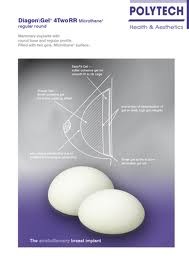 Polytech’s product range consists of around six-hundred implant types. A variety of sizes, textures and profiles are available, including anatomical, tear drop, moderate and high profiles.
Polytech’s product range consists of around six-hundred implant types. A variety of sizes, textures and profiles are available, including anatomical, tear drop, moderate and high profiles.
Polytech breast implants are filled with silicone gel with a very thick consistency. Due to this high consistency the implants keep their shape and have what is referred to as a ‘memory’, this means that even if the implants are squashed they will revert to their original shape.
The shell used for the breast implants consists of several silicone-elastomeric layers as well as a special barrier layer to prevent permeation of any silicone components. The surface of the shell can be either smooth or textured, or it can be covered with a layer of Microthane (micro polyurethane foam).
Although Polytech implants have a strong focus on breast implants for women, they also produce implants for men as well as facial, gluteus and calf implants. Custom-made implants can also be provided.
Polytech breast implants are ideal for minimizing the risk of capsular contracture: an abnormal response of the immune system to foreign materials in the human body. The use of Microthane to cover implants reduces the risk of capsular contracture and due to their surface structure, silicone textured implants have a reduced length and orientation of the fibres in the tissue capsule; therefore there is a minimal risk (around 1% after 15 years of implantation) of capsular contracture with these implants.
Polytech breast implants are designed to resemble the natural breast tissue in consistency, feel and movement.
All Polytech implants are CE certified which means that they conform to the latest European rules and regulations
From 2007 patients are offered a lifetime warranty, meaning that their breast implants will be replaced should they rupture or become damaged.
The following profiles are available:
Tear drop (RHT):
An implant with a round base and the highest point of projection in the lower third of the implant. This form resembles a very natural, slightly ptotic breast form.
Anatomical profile (AP):
Highest projection in the lower third; the implant basis is elliptic. This form resembles, similar to the tear drop form, a very natural, slightly ptotic breast form, however, giving more volume to the cranial region.
Moderate profile (RMP):
A round implant with its highest projection in the middle. A moderate profile in relation to the implant volume results in a lower projection than implants with high profile.
High profile (RHP):
A round implant with its highest projection in the middle. A high profile in relation to the implant volume results in a higher projection than implants with moderate profile.
For more information, please visit the www.polytechhealth.com website.
Useful links on breast implant safety:








